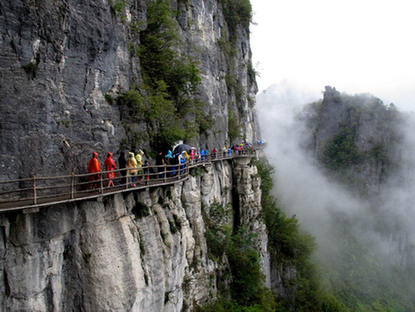A Trip to Enshi
EnshiI Tujia and Miao Autonomous Prefecture, established in 1983, is in southwestern Hubei Province. As the youngest autonomous prefecture in China and home to 29 ethnic minorities, Enshi boasts rich natural resources. Its forest coverage reaches nearly 70 percent, known as the “forest sea in western Hubei,” “treasurehouse of traditional Chinese medicine in central China,” and “city rich in selenium.”
In recent years, the local tourism industry has grown more and more prosperous. After seeing advertisements about Enshi and hearing travel stories from my friends, I dreamed of going there someday. One day, I saw an ad that said “Enshi – a hospitable land, and Tujia – a romantic ethnic group.” That day I decided to go to Enshi.
|
 |
|
A plank road along the face of a cliff in the grand canyon. |
After 20 hours on the train my friends and I finally arrived at our long-awaited destination — Enshi.
As soon as we got off the train we were welcomed by a wave of hot air, and took off our heavy autumn coats. Thanks to its monsoon-influenced subtropical climate, Enshi’s autumn temperature is a steady 20 degrees Celsius.
For our first day we chose a guided tour, so we wouldn’t have to worry about transportation. The first stop was Enshi Chieftain City. Located northwest of Enshi City, the Chieftain City covers an area of about 20 hectares. It is an ancient city with Tujia architecture, preserving the local aboriginal civilization. According to our tour guide, a young Tujia girl, the Tujia are descended from the Ba people who originally lived on the Jianghan Plain, between the Yangtze and Hanjiang rivers. Later the Ba people were pushed westwards under the expansion of the State of Chu. During the Spring and Autumn Period, the Ba people established the State of Ba. In 316 BC, the State of Ba was extinguished by the State of Qin. Some of the Ba people retreated to the Wuling area bordering Hunan, Hubei, Sichuan and Guizhou provinces and lived alongside other ethnic minorities. The Tujia refer to themselves as “Bizika” or “Beijingka.”
The Tusi system was a feudal system of appointing hereditary chieftains by the central authorities to rule ethnic minorities independently in a region, on the basis of imperial laws and proprieties. The Tusi system among Tujia peoples lasted about 450 years, between the Yuan and Qing dynasties. Enshi Chieftain City was the home of the most influential and powerful Tujia figure, the chieftain. The complex represents the essence of Tujia culture and architecture.
The city gate is a monumental building, representing the dignity and virtues of the chieftain. The tower is a wooden building 25 meters high and 12 meters wide, constructed with mortise and tenon joinery. The swirling staircases on either side connect each floor and lead to the top. There are 200 doors and windows decorated with carvings depicting opera and folk legends. The gate is designed as an allusion to ancient Chinese culture; there are four floors, 12 pillars and 24 beams, representing the four seasons, 12 months and 24 solar terms in every year. On the roof there is a statue of several bats holding an ancient coin, which signifies that “fortune is at hand.”
After touring the Chieftain City, we hurried to the next destination – Enshi Tujia Daughters’ City, a place featuring local folklore. It is located in Qiliping in downtown Enshi. The Daughters’ City is actually a folk street with restaurants, shops and entertainment. The street is built along the river, and the road, paved with grey breccia besides stilt houses, brings Tujia folk customs back to life today.
